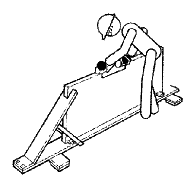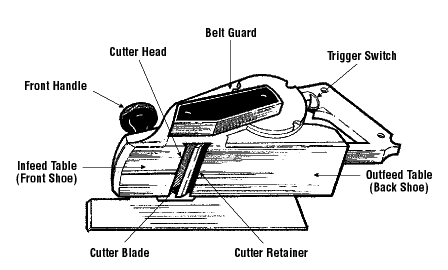Powered Hand Tools - Planers
On this page
What should you do before you start cutting with a planer?
Back to top- Wear safety glasses or goggles, or a face shield (with safety glasses or goggles).
- Use hearing protection suitable for the noise level of the planer.
- Use a respirator if working in dusty environments, especially with materials like hardwood or particleboard.
- Avoid wearing loose or baggy clothing and make sure that long hair is tied back.
- Disconnect the planer from the power supply (unplug or remove the battery) before making any adjustments to the cutter head or blades.
- Ensure the switch is in the off position before plugging it in or reconnecting power.
- Use blades of the same weight and set at the same height for balance and smooth operation.
- Make sure that the blade-locking screws are tight to prevent movement during use.
- Remove adjusting keys, wrenches, or other tools before turning on the power.
- Support the material (stock) in a stable and comfortable position to make sure safe and accurate cuts.
- Check stock thoroughly for staples, nails, screws, knots, or other foreign objects that could damage the blades or cause injury.
- Do not cut stock less than 20 cm (8 inches) long or 1 cm (0.5 inches) thick.
- Make sure the work area is clean and free from debris that could cause slips, trips, or falls.
- Maintain proper lighting to see the planer and stock clearly.
- Avoid distractions while operating the planer.
- If using a battery-powered planer:
- Inspect the battery for any damage, cracks, or leaks before use.
- Follow the manufacturer's instructions for charging and storing the battery. Avoid overcharging or exposing it to extreme temperatures. See Battery Charging - Lithium-ion Batteries for more information.

What should you do while cutting with a planer?
Back to top- Start a cut with the infeed table (front shoe) resting firmly on the stock and with the cutter head slightly behind the edge of the stock.
- Use two hands to operate the planer: one hand on the trigger switch and the other on the front handle.
- Do not put your finger or any object in a deflector to clean out chips while a planer is running.
- Always disconnect the power supply when stopping to dump out chips, or to inspect the bottom of the planer.
- Wait for the blades to come to a complete stop before setting the planer down to avoid unintentional contact.
- Stand on the side of the planer near the controls. Never stand behind the stock when it is being fed into the planer.
- Take only a small amount of material off at a time.

- Keep all cords and clothing clear of the cutting area.
- Maintain proper footing and balance to reduce the risk of slips or falls.
- Move the planer smoothly and at a controlled rate over the stock.
- Do not operate the planer in wet or damp conditions to avoid the risk of electric shock.
- Regularly clean wood chips and dust from the planer.
- Adjust the working height to a comfortable level to minimize strain on your back and arms.
Refer to Powered Hand Tools - Basic Safety for Electric Tools for general safety tips.
- Fact sheet last revised: 2025-04-30

